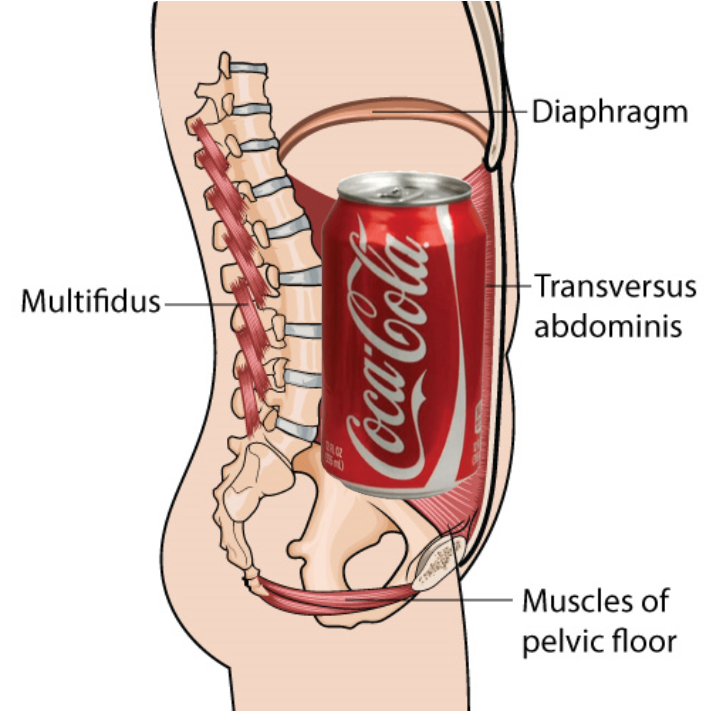“Activate your core!”
“Squeeze your core!”
“Tighten up your core!”
If you have been to physical therapy or seen a personal trainer, you’ve likely heard the term “activate your core”. But do you know what this really means? Do you know what your core is, actually? Well hopefully this post clarifies what the core is, how it works, and why it is important in movement and even not in movement!
Let’s start with anatomy:
The core is made of many muscles and a few different structures. Think of the core as a large soup can – it has a top, a bottom, and then an encasing cylinder to connect above and below. The top of our core is the diaphragm – this is our main muscle of respiration (breath).
Many people in our society tend to have difficulty breathing with the diaphragm and begin to breathe with accessory muscles in the neck, chest, and shoulders. The bottom of our core is the pelvic floor – this is a complex structure that males and females both have to help keep our organs in our trunk. This is often a neglected part of the core contraction. Now to the familiar muscles – the abdomen. We have the abdomis recti, the internal and external obliques, and the transverse abdominis. This is our front and side core. It includes very deep muscles that act like a corset around us to help stabilize our trunk. Lastly, we have our multifidi and smaller stabilizing muscles in our backs. These help to segmentally stabilize each vertebrae in our spines. Some anatomists and therapists also consider the glutes as part of the core.

So, what does the core do? The core muscles work in conjunction with each other to keep our organs in place, increase intrabdominal pressure (which actually makes us stronger in the moment), stabilize our spine, stabilize our trunk for our limbs to function better, and to help us breathe properly. These muscles do so much for us on a daily basis and are definitely one of the most important parts of our body for daily function.
So how do I activate my core? Listen up because this is the most important and useful part of this post. Here are a few ways and tips to think about while “activating your core”!
- Diaphragm: place one hand on your stomach and one on your chest – take a breath in and try to fill your belly first prior to your chest rising. Then let it all out. It doesn’t matter if you use nasal or mouth breath for this activity, but nasal breathing does have some additional perks. Taking a belly breath is the best way to ensure you’re using your diaphragm.
- Pelvic floor: This can be tricky for a lot of people. Think of a kegel exercise… a kegel is when you consciously contract your pelvic floor like you are trying to clinch your bottom and for lack of a better word, “pull up your genitals”. Another cue that helps many people is acting like you are trying to stop the flow of urination. For men, think about walking into a cold body of water – we’ve all been there! Make sure after you squeeze you relax that contraction fully.
- The abdominal muscles: there are many cues for this – pull your belly button toward your spine, pull your belt buckle towards your belly button, tuck your ribs, and smashing your back into the table are all very common. My personal favorite to ensure proper abdominal contraction is through using breath. Take a belly breath in, then on the exhale, draw your ribs down toward your feet. With exhalation, our abs naturally want to help, so we use this to our advantage with this technique. Once you are able to feel your belly tighten – you are ready to apply this technique to other functional activities such as lifting, bending, squatting, and carrying.
I hope this post helps clarify what the core is, why it is important, and how to activate it properly. If you have more questions about the core and how to activate it best for you individually give us a call at Innovative PT and schedule an in-person or virtual appointment!
Innovative Physical Therapy, “Solutions in Motion”
619-260-0750
info@innovativept.net